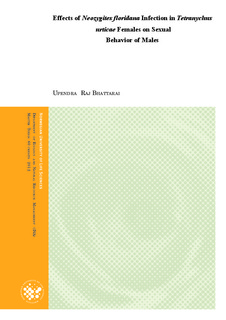| dc.description.abstract | The entomopathogenic fungus Neozygites floridana infects and kills the two-spotted spider mite, Tetranychus urticae, an important herbivorous pest worldwide. The fungal development stages in/ on the cadaver (mite infected and killed with N. floridana) might be described in three stages as: 1) non-sporulating cadaver 2) sporulating cadaver with primary conidia 3) sporulating cadaver with secondary (capilli) conidia. The last stage is the only stage which is infective to T. urticae. I tested the effects of these three cadaver stages on sexual behavior of T. urticae males in a series of experiments where males could choose between two non-moving females: a healthy quiescent deutonymph and a cadaver, placed individually on each of two slightly overlapping leaf discs. Results showed that cadaver stage had significantly affected the leaf disc choice of males. T. urticae males showed preference to leaf discs with non-sporulating cadavers and sporulating cadavers with primary conidia compared to healthy females. Conversely, T. urticae males preferred healthy females to sporulating cadavers with secondary conidia.
The frequency of two specific male behaviors, touching (male touching a female for less than 30 sec) and guarding (male mounted upon or within a body length of a female for 30 sec or longer) was also observed in this experiment. For touching, no significant difference between cadaver and healthy female was found for any of the three cadaver stages. Further, no significant difference in guarding of non-sporulating cadavers and healthy females was found. On the other hand, guarding rarely happened to primary conidia cadavers, and was never observed in secondary conidia cadavers.
To differentiate between the effect of fungal and female odor, an experiment where T. urticae males could choose between a non-sporulating male cadaver and a non-sporulating female cadaver was conducted. Results showed that males were more attracted to leaf discs with female cadavers than to leaf discs with male cadavers, and female cadavers were more often touched than male cadavers. Further, guarding was only observed for female cadavers.
Results presented above suggest that to T. urticae males, non-sporulating female cadavers are more attractive than healthy females. Moreover, males often approach and even touch cadavers that are full of infective conidia. This time-wasting and risky behavioral pattern demonstrates that the males are not well adapted to avoid N. floridana infection. However, they have the ability to avoid guarding cadavers full of spores. Sensory mechanisms of the male mites, together with texture and smell of the cadavers, may explain the results, but further studies are needed to conclude. If these results apply to biological control of T. urticae under larger-scale field conditions, female cadavers will spread N. floridana infection much faster with multifold mechanisms than male cadavers. | no_NO |
